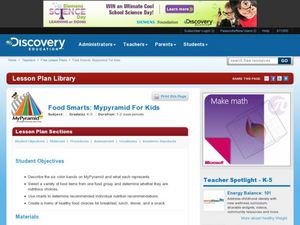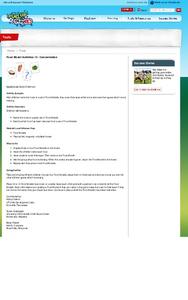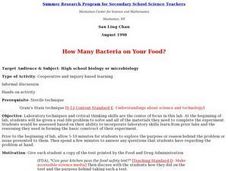Chicago Botanic Garden
The Carbon Cycle
There is 30 percent more carbon in the atmosphere today than there was 150 years ago. The first lesson in the four-part series teaches classes about the carbon cycle. Over two to three days, classes make a model of the cycle,...
NOAA
Through Robot Eyes
How do robots assist ocean explorers in collecting data and images? The final installment in a five-part series has science scholars examine underwater images collected by robots and identify the organisms shown. Groups then calculate...
EduGAINs
Consumerism, Me and the Natural Environment— Canadian and World Studies
Just as no man is an island, no country is totally independent of other countries. To understand the impact of individual consumer decisions on the global natural environment, class groups consider how the stuff they...
American Statistical Association
Step into Statastics
Class members study the size of classmates' feet and perform a statistical analysis of their data. They solve for central tendencies, quartiles, and spread for the entire group as well as subgroups. They then write a conclusion based on...
Curated OER
Primary PE Lesson
Young scholars divide into two groups facing each other; tossing the bean bags to each other. The teacher calls out names of unhealthy food and students start to throw beanbags back and forth to their partner. When young scholars hear a...
Curated OER
Unpacking the Grocery Bag
Students unpack a grocery bag and categorize the food in many different ways. In this groceries lesson plan, students can categorize it by the four food groups, perishable/non perishable, domestic and international foods, and more.
Curated OER
We Need All Five!
Second graders review foods and their groups. They discuss the reasons why they need to eat from all five food groups. They try to write using only a few of their five fingers to see what happens when you don't use all five fingers.
Curated OER
Moving Down the Line
Students examine food models to determine what food group they belong to and create a balanced meal as they travel through a mock cafeteria buffet line.
Arizona Board of Regents
The Pyramid of Power
Students explore the food pyramid, nutrition, and how to plan a balanced diet. This fun lesson is well-planned and a great introduction to the food pyramid!
Curated OER
Climbing the Pyramid
Students examine the Food Pyramid to discover the foods they need to eat to have a healthy body. Using food brought to class, they must place the food in the correct category in the pyramid. In groups, they test food samples for fat...
Curated OER
From Moo to You
Students listen to a story about cows and identify foods made from milk. They have a tasting party and practice a finger play called "Five Mugs of Milk."
Curated OER
Foods and Languages of the World
Students celebrate diversity. In this multicultural appreciation lesson, students celebrate diversity by sampling food from different cultures, learning a few words in Spanish and identifying the seven different continents.
Curated OER
Visual Vocabulary
Students interpret and name the vocabulary termed acted out by the mime. In this science/language arts/physical education lesson, students are given a set of vocabulary terms to discuss within their group. Next, students place all...
Curated OER
Food Pyramid Lab
Third graders complete a lab to review the Food Guide Pyramid and prepare a food item using all of the food groups.
Curated OER
Food Smarts: Mypyramid For Kids
Students create a menu based on the nutritious choices they pick out from MyPyramid and the video they watch. In this nutrition lesson plan, students describe what each color band on the pyramid represents, use charts, discuss nutrition...
Curated OER
Label It Nutrition
Pupils rank foods for particular nutrients, and check to see if they are correct using the Nutrition Label.
Curated OER
Queen Anna Banana's Fruit Group
Second graders participate in activities focusing on the fruit group and rhyming words.
Curated OER
Circle of Life
Students consider why we eat and where our food obtains its energy. They illustrate food chains that might be found on an open field, dissect owl pellets, identify the remains of animals in the pellets, watch videos and participate in...
Curated OER
Concentration
Students recognize sets of food pictures. In this food concentration lesson, students match food names and models. Students who name the most correctly win the game.
Curated OER
Old Growth Forest Mural
Learners explore the four characteristics of an old growth forest. In this forest lesson, students research old growth forests and their inhabitants. Learners work in four separate groups and create a mural for their characteristic of an...
Curated OER
What Food Is It?
Students close their eyes and taste foods without using the sense of sight to identify the foods. They record what they think the food is that they tasted.
Curated OER
How Many Bacteria on Your Food?
High schoolers discuss and conduct a food safety experiment which looks at bacteria and food poisoning. They swab the other area of some food and grow bacteria in an agar plate.
Curated OER
Funky Food Farm
Students research about ways to keep food from spoiling. In this health science lesson, students design an experiment to keep the ice cubes from melting. They present their designs and results in class.
Curated OER
Southeast Asian Food and Culture
Pupils become familiar with some of the food of Southeast Asia. The explore various examples of how culture has been shaped through the influence of food within Southeast Asia.























